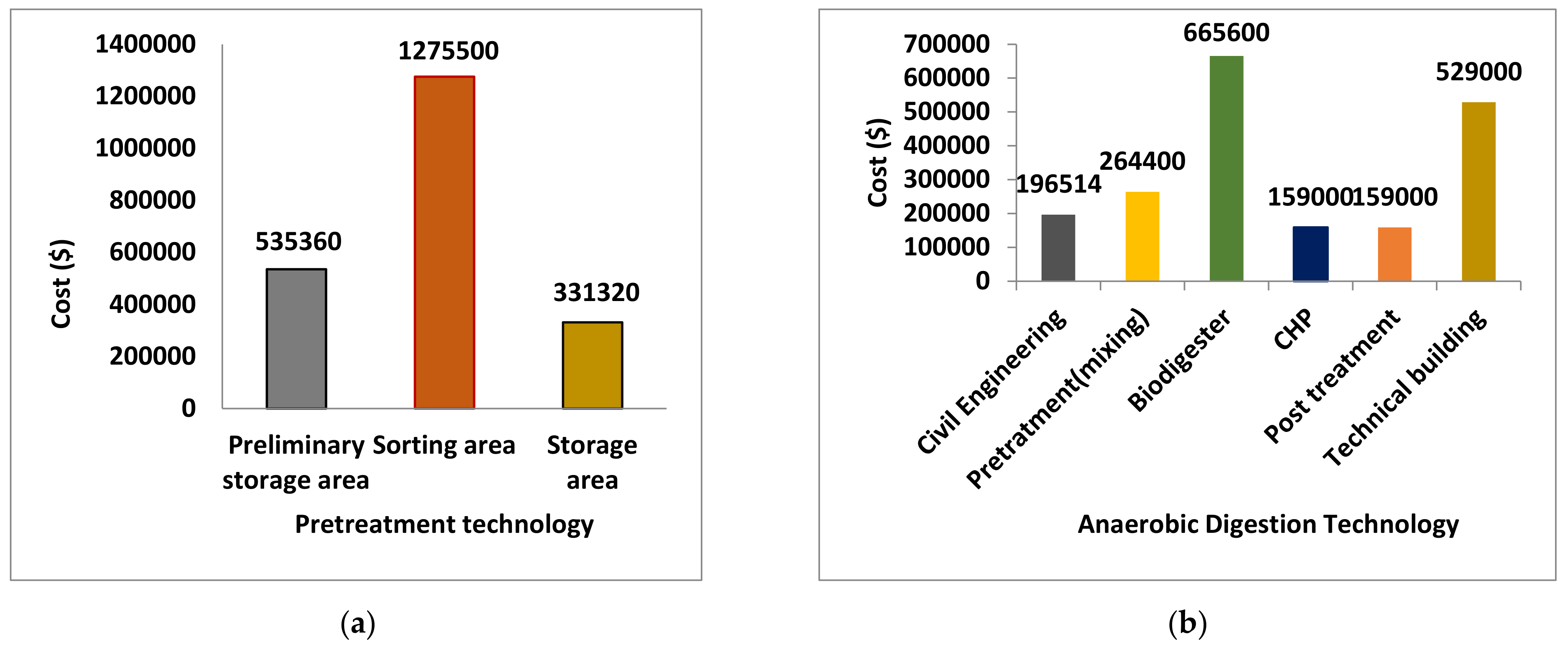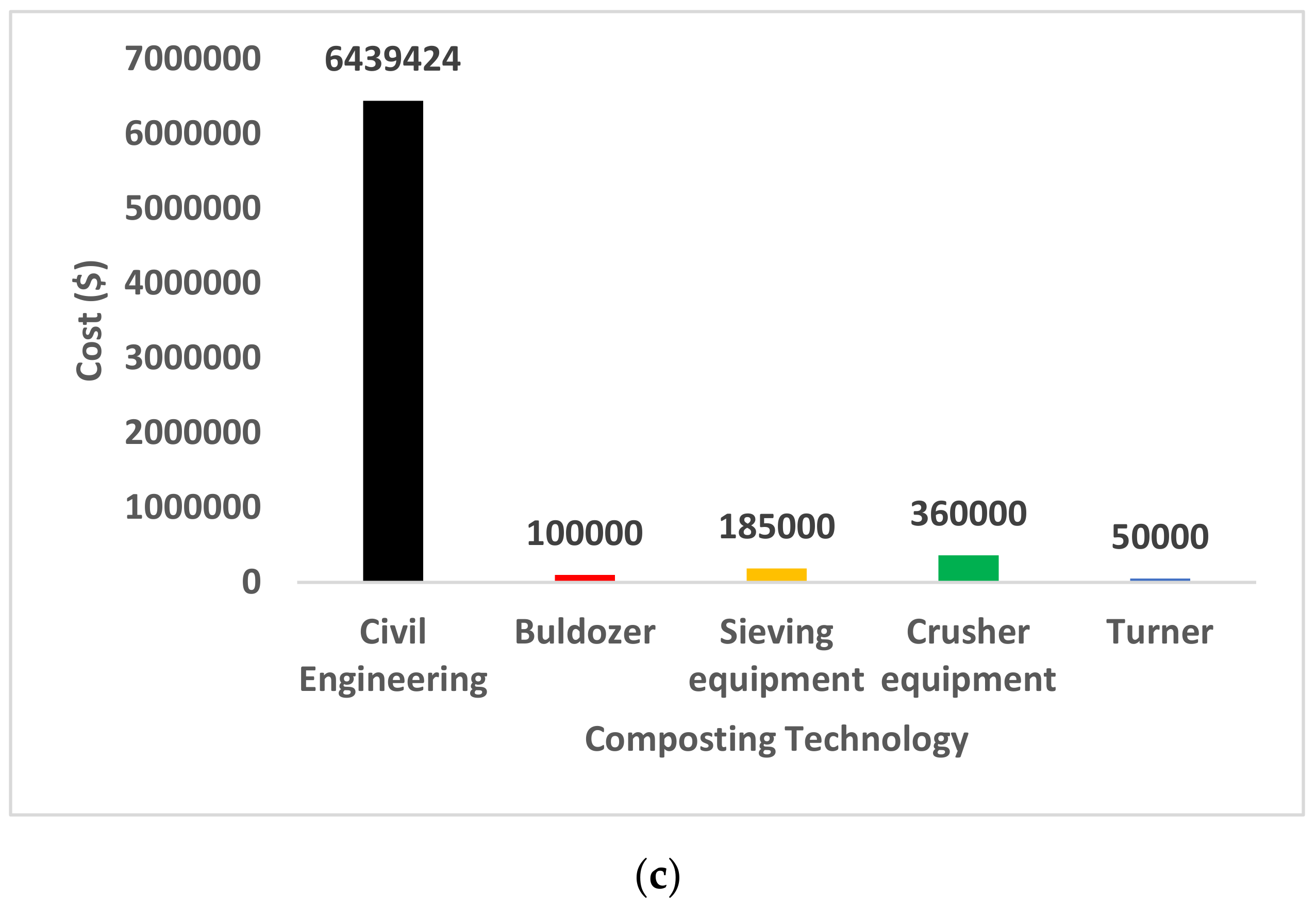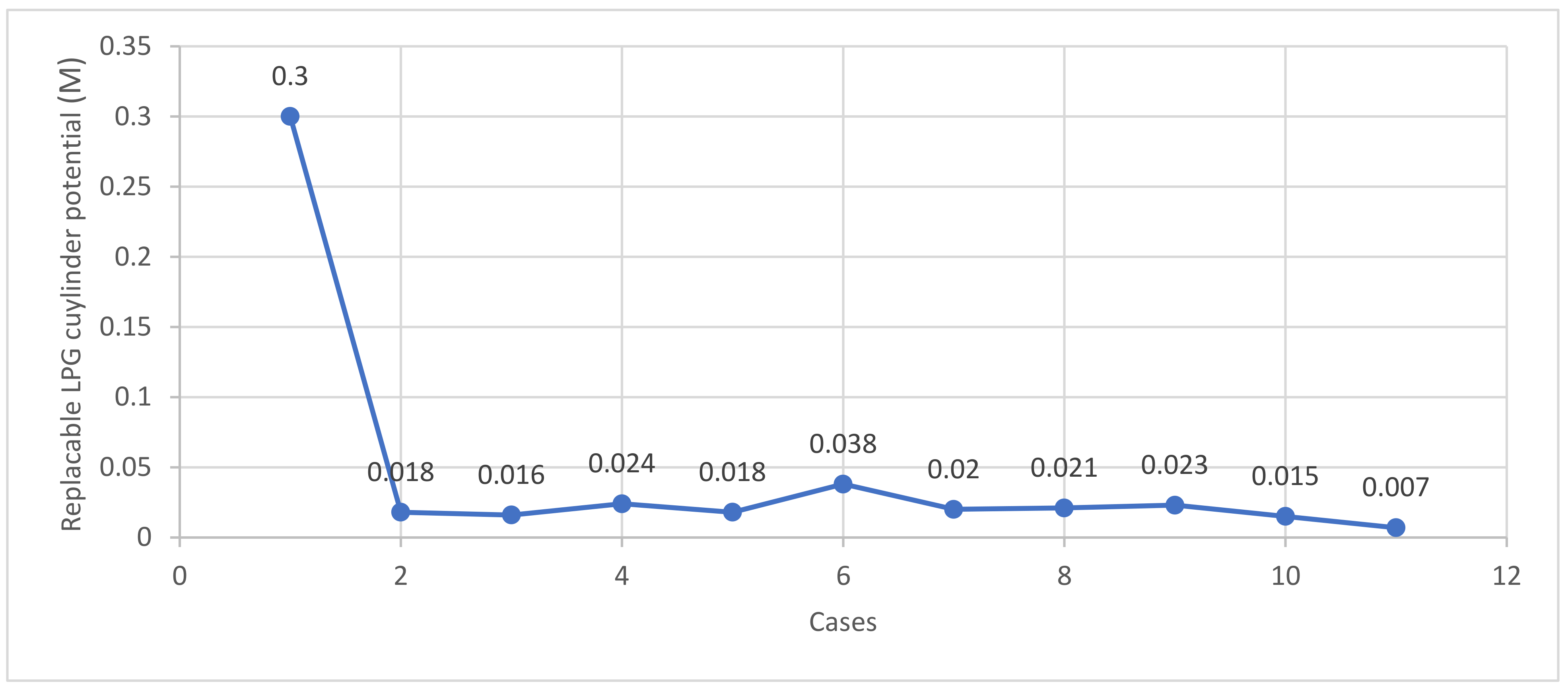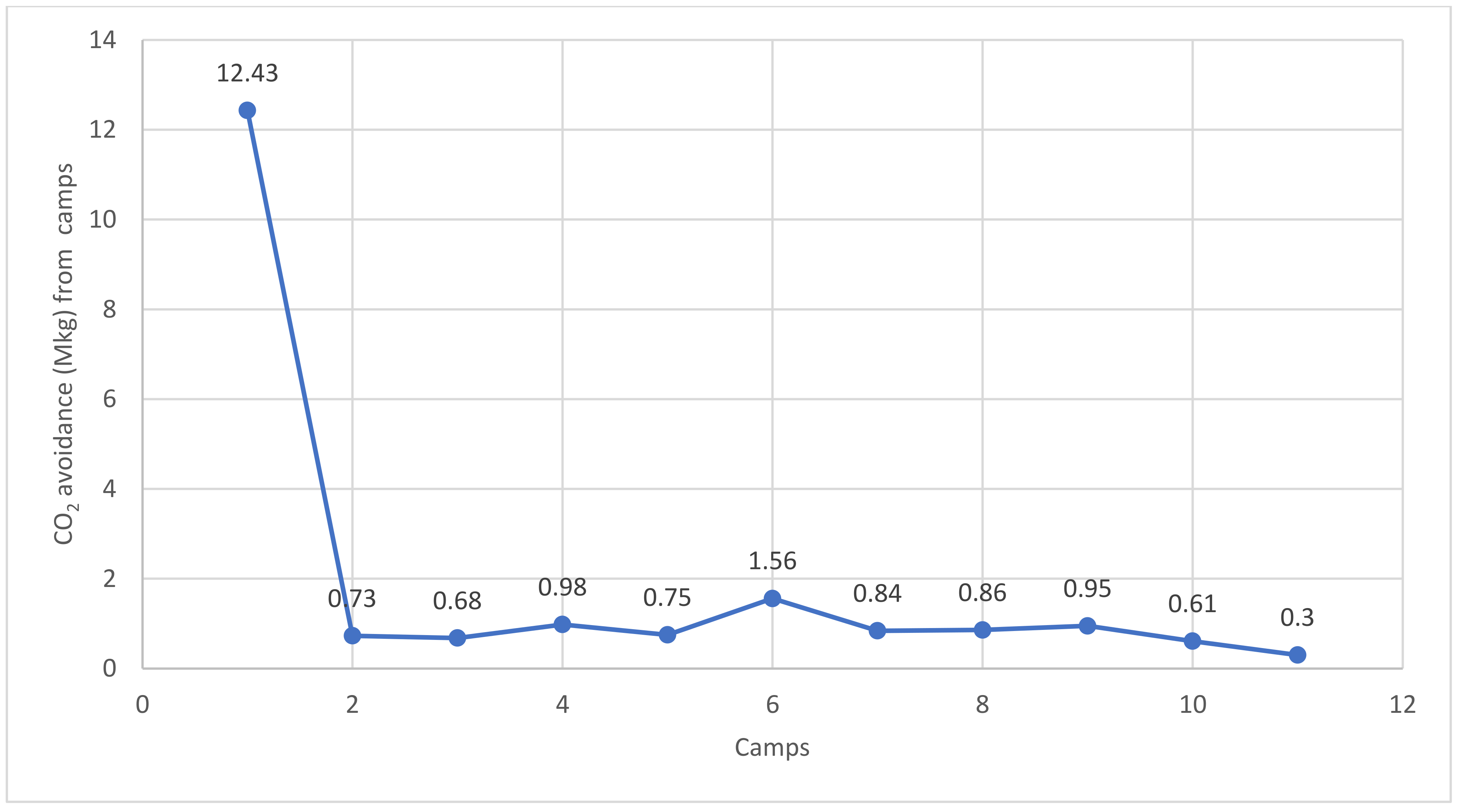Role of Biogas in Achieving Sustainable Development Goals in Rohingya Refugee Camps in Bangladesh
Abstract
:1. Introduction
2. Current Cooking Energy Situation in Rohingya Refugee Camps
3. Material and Methods
3.1. Household Digesters
3.2. Environmental Analysis
4. Results and Discussion
4.1. Present Waste Situation and Economic Benefit of AD
4.2. Emission and LPG Reduction Potential
5. Biogas for Meeting SDG in Refugee Camps
6. Conclusions
Supplementary Materials
Author Contributions
Funding
Institutional Review Board Statement
Informed Consent Statement
Data Availability Statement
Conflicts of Interest
Nomenclature
| LPG | Liquefied petroleum gas |
| MSW | Municipal Solid Waste |
| SDG | Sustainable Development Goals |
| UNHCR | United Nations High Commissioner for Refugees |
References
- UNHCR-Global Trends. Available online: https://www.unhcr.org/globaltrends.html (accessed on 5 September 2022).
- Haver, K.; Harmer, A.; Taylor, G.; Khara Latimore, T. Evaluation of European Commission Integrated Approach of Food Security and Nutrition in Humanitarian Context; European Commission: Luxembourg, 2013. [Google Scholar]
- Barbieri, J.; Riva, F.; Colombo, E. Cooking in Refugee Camps and Informal Settlements: A Review of Available Technologies and Impacts on the Socio-Economic and Environmental Perspective. Sustain. Energy Technol. Assess. 2017, 22, 194–207. [Google Scholar] [CrossRef]
- UNHCR Northern Europe. Available online: https://www.unhcr.org/neu/unhcr-and-sustainable-development-goals (accessed on 30 January 2022).
- Rafa, N.; van To, T.T.; Gupta, M.; Uddin, S.M.N. The Pursuit of Energy in Refugee Contexts: Discrimination, Displacement, and Humanitarian Energy Access for the Rohingya Refugees Displaced to Bangladesh. Energy Res. Soc. Sci. 2022, 83, 102334. [Google Scholar] [CrossRef]
- Mandelli, S.; Barbieri, J.; Mattarolo, L.; Colombo, E. Sustainable Energy in Africa: A Comprehensive Data and Policies Review. Renew. Sustain. Energy Rev. 2014, 37, 656–686. [Google Scholar] [CrossRef]
- Transforming Our World: The 2030 Agenda for Sustainable Development | Department of Economic and Social Affairs. Available online: https://sdgs.un.org/2030agenda (accessed on 30 January 2022).
- Fuso Nerini, F.; Tomei, J.; To, L.S.; Bisaga, I.; Parikh, P.; Black, M.; Borrion, A.; Spataru, C.; Castán Broto, V.; Anandarajah, G.; et al. Mapping Synergies and Trade-Offs between Energy and the Sustainable Development Goals. Nat. Energy 2018, 3, 10–15. [Google Scholar] [CrossRef]
- UNHCR; IOM; UNITAR; UN Environment; Global Alliance for Clean Cookstoves; Chatham House. A Policy Brief on Energy in Situations of Displacement. 2018, pp. 1–7. Available online: https://sustainabledevelopment.un.org/content/documents/17561PB_17_Draft.pdf (accessed on 22 July 2022).
- Neves, D.; Baptista, P.; Pires, J.M. Sustainable and Inclusive Energy Solutions in Refugee Camps: Developing a Modelling Approach for Energy Demand and Alternative Renewable Power Supply. J. Clean Prod. 2021, 298, 126745. [Google Scholar] [CrossRef]
- Chowdhury, H.; Chowdhury, T.; Miskat, M.I.; Hossain, N.; Chowdhury, P.; Sait, S.M. Potential of Biogas and Bioelectricity Production from Rohingya Camp in Bangladesh: A Case Study. Energy 2021, 214, 118837. [Google Scholar] [CrossRef]
- Hassan, M.M.; Smith, A.C.; Walker, K.; Rahman, M.K.; Southworth, J. Rohingya Refugee Crisis and Forest Cover Change in Teknaf, Bangladesh. Remote Sens. 2018, 10, 689. [Google Scholar] [CrossRef]
- Bangladesh Refugee Emergency Factsheet: Energy and Environment (as of August 2018)-Bangladesh | ReliefWeb. Available online: https://reliefweb.int/report/bangladesh/bangladesh-refugee-emergency-factsheet-energy-and-environment-august-2018 (accessed on 30 January 2022).
- Sustainable Energy Sources for Rohingya Refugees in Kutupalong—Children on the Edge. Available online: https://www.childrenontheedge.org/latest-stories/kutupalong-sustainableenergy (accessed on 30 January 2022).
- Dignifying Sanitation Services for the Rohingya Refugees in Cox’s Bazar Camps-Www.Rural21.Com. Available online: https://www.rural21.com/english/news/detail/article/dignifying-sanitation-services-for-the-rohingya-refugees-in-coxs-bazar-camps.html?no_cache=1 (accessed on 18 May 2022).
- Rosenthal, J.; Quinn, A.; Grieshop, A.P.; Pillarisetti, A.; Glass, R.I. Clean Cooking and the SDGs: Integrated Analytical Approaches to Guide Energy Interventions for Health and Environment Goals. Energy Sustain. Dev. 2018, 42, 152–159. [Google Scholar] [CrossRef]
- Refugee Crisis, Green Energy, and Climate Responsibility | The Daily Star. Available online: https://www.thedailystar.net/opinion/news/refugee-crisis-green-energy-and-climate-responsibility-2095797 (accessed on 30 January 2022).
- Khan, E.U.; Martin, A.R. Review of Biogas Digester Technology in Rural Bangladesh. Renew. Sustain. Energy Rev. 2016, 62, 247–259. [Google Scholar] [CrossRef]
- Morris, B.; Chopyak, E.; Gray, A. October 2017 Assessment Report: Undocumented Myanmar Nationals Influx to Cox’s Bazar, Bangladesh; International Rescue Committee: New York, NY, USA, 2017. [Google Scholar]
- Sagastume Gutiérrez, A.; Mendoza Fandiño, J.M.; Cabello Eras, J.J.; Sofan German, S.J. Potential of Livestock Manure and Agricultural Wastes to Mitigate the Use of Firewood for Cooking in Rural Areas. The Case of the Department of Cordoba (Colombia). Dev. Eng. 2022, 7, 100093. [Google Scholar] [CrossRef]
- Solar Improves Living Standards for Rohingya Refugees in Bangladesh—Pv Magazine International. Available online: https://www.pv-magazine.com/2021/06/02/solar-improves-living-standards-for-rohingya-refugees-in-bangladesh/ (accessed on 26 February 2022).
- Deng, L.; Liu, Y.; Wang, W. Biogas Technology; Springer: Singapore, 2020; ISBN 9789811549403. [Google Scholar]
- Bruun, S.; Jensen, L.S.; Khanh Vu, V.T.; Sommer, S. Small-Scale Household Biogas Digesters: An Option for Global Warming Mitigation or a Potential Climate Bomb? Renew. Sustain. Energy Rev. 2014, 33, 736–741. [Google Scholar] [CrossRef]
- Roubík, H.; Barrera, S.; van Dung, D.; Phung, L.D.; Mazancová, J. Emission Reduction Potential of Household Biogas Plants in Developing Countries: The Case of Central Vietnam. J. Clean. Prod. 2020, 270, 122257. [Google Scholar] [CrossRef]
- Lemma, B.; Ararso, K.; Evangelista, P.H. Attitude towards Biogas Technology, Use and Prospects for Greenhouse Gas Emission Reduction in Southern Ethiopia. J. Clean. Prod. 2021, 283, 124608. [Google Scholar] [CrossRef]
- Nguyen, D.; Nitayavardhana, S.; Sawatdeenarunat, C.; Surendra, K.C.; Khanal, S.K. Biogas Production by Anaerobic Digestion: Status and Perspectives. In Biomass, Biofuels, Biochemicals: Biofuels: Alternative Feedstocks and Conversion Processes for the Production of Liquid and Gaseous Biofuels; Elsevier: Amsterdam, The Netherlands, 2019; pp. 763–778. ISBN 9780128168561. [Google Scholar]
- Jegede, A.O.; Zeeman, G.; Bruning, H. A Review of Mixing, Design and Loading Conditions in Household Anaerobic Digesters. Crit. Rev. Environ. Sci. Technol. 2019, 49, 2117–2153. [Google Scholar] [CrossRef]
- Yasar, A.; Nazir, S.; Rasheed, R.; Tabinda, A.B.; Nazar, M. Economic Review of Different Designs of Biogas Plants at Household Level in Pakistan. Renew. Sustain. Energy Rev. 2017, 74, 221–229. [Google Scholar] [CrossRef]
- Ferrer-Martí, L.; Ferrer, I.; Sánchez, E.; Garfí, M. A Multi-Criteria Decision Support Tool for the Assessment of Household Biogas Digester Programmes in Rural Areas. A Case Study in Peru. Renew. Sustain. Energy Rev. 2018, 95, 74–83. [Google Scholar] [CrossRef]
- UNDP Bangladesh and UN WOMEN Bangladesh. Report on Environmental Impact on Rohingya Influx; UNDP: Dhaka, Bangladesh, 2018; p. 106. [Google Scholar]
- Mishra, A.; Kumar, M.; Bolan, N.S.; Kapley, A.; Kumar, R.; Singh, L. Multidimensional Approaches of Biogas Production and Up-Gradation: Opportunities and Challenges. Bioresour. Technol. 2021, 338, 125514. [Google Scholar] [CrossRef]
- Tyagi, V.K.; Fdez-Güelfo, L.A.; Zhou, Y.; Álvarez-Gallego, C.J.; Garcia, L.I.R.; Ng, W.J. Anaerobic Co-Digestion of Organic Fraction of Municipal Solid Waste (OFMSW): Progress and Challenges. Renew. Sustain. Energy Rev. 2018, 93, 380–399. [Google Scholar] [CrossRef]
- SREDA. Feasibility Study on Waste to Energy Conversion in Six Municipalities in Bangladesh; UNDP: Dhaka, Bangladesh, 2018; Available online: http://www.bd.undp.org/content/bangladesh/en/home/library/environment_energy/waste-to-energy.html (accessed on 22 July 2022).
- Bhaiya, R. Community Based Solid Waste Management through Public-Private-Community Partnerships: Experience of Waste Concern in Bangladesh. Available online: https://www.academia.edu/36828164/Community_Based_Solid_Waste_Management_Through_Public-Private-Community_Partnerships_Experience_of_Waste_Concern_in_Bangladesh (accessed on 22 July 2022).
- Uddin, M.M.; Wright, M.M. Anaerobic Digestion Fundamentals, Challenges, and Technological Advances. Phys. Sci. Rev. 2022. [Google Scholar] [CrossRef]
- AgSTAR Program, E.; United States Environmental Protection Agency (EPA). Anaerobic Digester/Biogas System Operator Guidebook A Guidebook for Operating Anaerobic Digestion/Biogas Systems on Farms in the United States. 2020. Available online: https://www.epa.gov/agstar/anaerobic-digesterbiogas-system-operator-guidebook (accessed on 22 July 2022).
- Lohani, S.P.; Dhungana, B.; Horn, H.; Khatiwada, D. Small-Scale Biogas Technology and Clean Cooking Fuel: Assessing the Potential and Links with SDGs in Low-Income Countries—A Case Study of Nepal. Sustain. Energy Technol. Assess. 2021, 46, 101301. [Google Scholar] [CrossRef]
- Weyant, C.L.; Thompson, R.; Lam, N.L.; Upadhyay, B.; Shrestha, P.; Maharjan, S.; Rai, K.; Adhikari, C.; Fox, M.C.; Pokhrel, A.K. In-Field Emission Measurements from Biogas and Liquified Petroleum Gas (LPG) Stoves. Atmosphere 2019, 10, 729. [Google Scholar] [CrossRef]
- Paolini, V.; Petracchini, F.; Segreto, M.; Tomassetti, L.; Naja, N.; Cecinato, A. Environmental impact of biogas: A short review of current knowledge. J. Environ. Sci. Health A Toxic Hazard. Subst. Environ. Eng. 2018, 53, 899–906. [Google Scholar] [CrossRef]
- Obaideen, K.; Abdelkareem, M.A.; Wilberforce, T.; Elsaid, K.; Sayed, E.T.; Maghrabie, H.M.; Olabi, A.G. Biogas Role in Achievement of the Sustainable Development Goals: Evaluation, Challenges, and Guidelines. J. Taiwan Inst. Chem. Eng. 2022, 131, 104207. [Google Scholar] [CrossRef]
- Herrmann, A. Biogas Production from Maize: Current State, Challenges and Prospects. 2. Agronomic and Environmental Aspects. Bioenergy Res. 2013, 6, 372–387. [Google Scholar] [CrossRef]
- Arthurson, V. Closing the Global Energy and Nutrient Cycles through Application of Biogas Residue to Agricultural Land—Potential Benefits and Drawbacks. Energies 2009, 2, 226–242. [Google Scholar] [CrossRef]
- Zeng, J.; Xu, R.; Sun, R.; Niu, L.; Liu, Y.; Zhou, Y.; Zeng, W.; Yue, Z. Evaluation of Methane Emission Flux from a Typical Biogas Fermentation Ecosystem in China. J. Clean. Prod. 2020, 257, 120441. [Google Scholar] [CrossRef]
- Ilo, O.P.; Simatele, M.D.; Nkomo, S.L.; Mkhize, N.M.; Prabhu, N.G. The Benefits of Water Hyacinth (Eichhornia Crassipes) for Southern Africa: A Review. Sustainability 2020, 12, 9222. [Google Scholar] [CrossRef]
- Tamburini, E.; Gaglio, M.; Castaldelli, G.; Fano, E.A. Biogas from Agri-Food and Agricultural Waste Can Appreciate Agro-Ecosystem Services: The Case Study of Emilia Romagna Region. Sustainability 2020, 12, 8392. [Google Scholar] [CrossRef]
- Adnan, A.I.; Ong, M.Y.; Nomanbhay, S.; Chew, K.W.; Show, P.L. Technologies for Biogas Upgrading to Biomethane: A Review. Bioengineering 2019, 6, 92. [Google Scholar] [CrossRef]
- Ullah Khan, I.; Hafiz Dzarfan Othman, M.; Hashim, H.; Matsuura, T.; Ismail, A.F.; Rezaei-DashtArzhandi, M.; Wan Azelee, I. Biogas as a Renewable Energy Fuel—A Review of Biogas Upgrading, Utilisation and Storage. Energy Convers. Manag. 2017, 150, 277–294. [Google Scholar] [CrossRef]
- Okoro, O.V.; Sun, Z. Desulphurisation of Biogas: A Systematic Qualitative and Economic-Based Quantitative Review of Alternative Strategies. ChemEngineering 2019, 3, 76. [Google Scholar] [CrossRef]
- Hansupalak, N.; Piromkraipak, P.; Tamthirat, P.; Manitsorasak, A.; Sriroth, K.; Tran, T. Biogas Reduces the Carbon Footprint of Cassava Starch: A Comparative Assessment with Fuel Oil. J. Clean. Prod. 2016, 134, 539–546. [Google Scholar] [CrossRef]
- Abdul Aziz, N.I.H.; Hanafiah, M.M.; Mohamed Ali, M.Y. Sustainable Biogas Production from Agrowaste and Effluents—A Promising Step for Small-Scale Industry Income. Renew. Energy 2019, 132, 363–369. [Google Scholar] [CrossRef]
- Kelebe, H.E.; Ayimut, K.M.; Berhe, G.H.; Hintsa, K. Determinants for Adoption Decision of Small Scale Biogas Technology by Rural Households in Tigray, Ethiopia. Energy Econ. 2017, 66, 272–278. [Google Scholar] [CrossRef]
- Lewis, J.J.; Hollingsworth, J.W.; Chartier, R.T.; Cooper, E.M.; Foster, W.M.; Gomes, G.L.; Kussin, P.S.; MacInnis, J.J.; Padhi, B.K.; Panigrahi, P.; et al. Biogas Stoves Reduce Firewood Use, Household Air Pollution, and Hospital Visits in Odisha, India. Environ. Sci. Technol. 2016, 51, 560–569. [Google Scholar] [CrossRef]
- Lima, R.M.; Santos, A.H.M.; Pereira, C.R.S.; Flauzino, B.K.; Pereira, A.C.O.S.; Nogueira, F.J.H.; Valverde, J.A.R. Spatially Distributed Potential of Landfill Biogas Production and Electric Power Generation in Brazil. Waste Manag. 2018, 74, 323–334. [Google Scholar] [CrossRef]
- Tamburini, E.; Gaglio, M.; Castaldelli, G.; Fano, E.A. Is Bioenergy Truly Sustainable When Land-Use-Change (LUC) Emissions Are Accounted for? The Case-Study of Biogas from Agricultural Biomass in Emilia-Romagna Region, Italy. Sustainability 2020, 12, 3260. [Google Scholar] [CrossRef]
- Zhang, J.; Mauzerall, D.L.; Zhu, T.; Liang, S.; Ezzati, M.; Remais, J.V. Environmental Health in China: Progress towards Clean Air and Safe Water. Lancet 2010, 375, 1110–1119. [Google Scholar] [CrossRef]
- Indoor Air Pollution a Huge Problem in Rohingya Camps | Dhaka Tribune. Available online: https://archive.dhakatribune.com/bangladesh/nation/2018/08/27/indoor-air-pollution-a-huge-problem-in-rohingya-camps (accessed on 13 February 2022).
- Mahmood, H.; Saha, C.; Paul, N.; Deb, S.; Abdullah, S.M.R.; Tanvir, M.S.S.I.; Bashar, A.; Roy, S.; Rabby, F.; Ahmed, S.N.; et al. The Soil Quality of the World’s Largest Refugee Campsites Located in the Hill Forest of Bangladesh and the Way Forward to Improve the Soil Quality. Environ. Chall. 2021, 3, 100048. [Google Scholar] [CrossRef]
- Sakamoto, M.; Ullah, S.M.A.; Tani, M. Land Cover Changes after the Massive Rohingya Refugee Influx in Bangladesh: Neo-Classic Unsupervised Approach. Remote Sens. 2021, 13, 5056. [Google Scholar] [CrossRef]
- Akhter, M.; Uddin, S.M.N.; Rafa, N.; Hridi, S.M.; Staddon, C.; Powell, W. Drinking Water Security Challenges in Rohingya Refugee Camps of Cox’s Bazar, Bangladesh. Sustainability 2020, 12, 7325. [Google Scholar] [CrossRef]
- Renewable Energy and Jobs—Annual Review 2020. Available online: https://www.irena.org/publications/2020/Sep/Renewable-Energy-and-Jobs-Annual-Review-2020 (accessed on 13 February 2022).





| Location | Origin | Number | Reference Period | Deforestation Rate |
|---|---|---|---|---|
| Sudan (Darfur) | Sudan | 2 million | 2003–2008 | The firewood consumption rate is calculated at 1500 tons per day. |
| DRC (Virunga region) | Rwanda | ≈730,000 | 1994–1996 | The firewood consumption rate is estimated at 1000 tons per day |
| Tanzania (North-Western) | Rwanda | 524,000 | 1994–1996 | The firewood consumption rate is measured at 585,000 m3 per year in Ngara district |
| Zimbabwe | Mozambique | - | 1985–1994 | 58% reduction in woodland cover around the camps |
| Malawi | Mozambique | >1 million | 1985–1995 | The firewood consumption rate is estimated between 500,000 and 700,000 m3 per year. |
| Camp | Population (2019) | Projected Population (2025) |
|---|---|---|
| Kutupalong-Balukhali Expansion1 (Case 1) | 439,623 | 545,618 |
| Kutupalong Registered Camp (Case 2) | 25,743 | 31,950 |
| Leda Makeshift (Case 3) | 24,026 | 29,819 |
| Nayapara Registered Camp (Case 4) | 34,557 | 42,889 |
| Shamlapour (Case 5) | 26,326 | 32,674 |
| Hakimpara (Case 6) | 55,181 | 68,486 |
| Thangkhali (Case 7) | 29,704 | 36,866 |
| Unchiprang (Case 8) | 30,384 | 37,710 |
| Jamtoli (Case 9) | 33,298 | 41,327 |
| Moynarghona (Case 10) | 21,464 | 26,640 |
| Chakmarkul (Case 11) | 10,500 | 13,032 |
| Digester Size (m3) | CAPEX (USD) | OPEX (USD/year) | Total (USD) | ||||||
|---|---|---|---|---|---|---|---|---|---|
| Poly. | Geo. | Fixed | Poly. | Geo. | Fixed | Poly. | Geo. | Fixed | |
| 4 | - | - | 1083 | - | - | 43 | - | - | 1949 |
| 5 | 198 | 480 | - | 794 | 961 | - | 992 | 1441 | - |
| 6 | - | - | 1333 | - | - | 53 | - | - | 2399 |
| 8 | - | - | 1583 | - | - | 63 | - | - | 2849 |
| 10 | 392 | 956 | 1833 | 1568 | 1912 | 73 | 1960 | 2868 | 3299 |
| 15 | 585 | 1431 | - | 2341 | 2863 | - | 2926 | 4294 | - |
| Recyclable Materials | Cost (USD/kg) | Recovery Rate (%) | Revenue Earning | Collection Fee (USD/month) |
|---|---|---|---|---|
| Paper | 0.16–0.21 | 40 | Normal Collection rate | 1.37 |
| Plastic | 0.25–0.29 | 50 | Collection rate (CR) + 5% increase | 1.44 |
| Glass | 0.21–0.22 | Not available | CR + 15% increase | 1.58 |
| Metal | 0.39–0.43 | 80 | CR + 30% increase | 1.78 |
| Others (textile) a | 0.17–0.18 | 75 | CR + 50% increase | 2.06 |
| Emission of Gas during per MJ of Supplied Energy | CO (g) | CO2 (g) | N2O (mg) | CH4 (mg) |
|---|---|---|---|---|
| Biogas | 0.1 | 81.5 | 5.4 | 57 |
| Wood | 14 | 532 | 4.3 | 600 |
| Sustainable Development Goals | Contribution of Biogas | Sustainable Development |
|---|---|---|
| SDG 1: No poverty |
| Economic |
| SDG 2: Zero hunger |
| Economic |
| ||
| SDG 3: Good Health and Well-being | Social | |
| SDG 4: Quality Education |
| Social |
| SDG 5: Gender Equality |
| Social |
| SDG 6: Clean Water and Sanitation |
| Environment |
| ||
| SDG 7: Affordable and Clean Energy |
| Environment |
| SDG 8: Decent work and Economic Growth | Economic | |
| SDG 9: Industry, Innovation, and Infrastructure |
| Economic |
| ||
| SDG 11: Sustainable Cities and Communities |
| Social |
| ||
| SDG 12: Responsible Consumption and Production |
| Environment |
| SDG 13: Climate Action | Environment | |
| SDG 14: Life Below Water |
| Environment |
| SDG 15: Life on Land |
| Environment |
| ||
| SDG 16: Peace and Justice Strong Institutions |
| Social |
Publisher’s Note: MDPI stays neutral with regard to jurisdictional claims in published maps and institutional affiliations. |
© 2022 by the authors. Licensee MDPI, Basel, Switzerland. This article is an open access article distributed under the terms and conditions of the Creative Commons Attribution (CC BY) license (https://creativecommons.org/licenses/by/4.0/).
Share and Cite
Chowdhury, H.; Chowdhury, T.; Sharifi, A.; Corkish, R.; Sait, S.M. Role of Biogas in Achieving Sustainable Development Goals in Rohingya Refugee Camps in Bangladesh. Sustainability 2022, 14, 11842. https://doi.org/10.3390/su141911842
Chowdhury H, Chowdhury T, Sharifi A, Corkish R, Sait SM. Role of Biogas in Achieving Sustainable Development Goals in Rohingya Refugee Camps in Bangladesh. Sustainability. 2022; 14(19):11842. https://doi.org/10.3390/su141911842
Chicago/Turabian StyleChowdhury, Hemal, Tamal Chowdhury, Ayyoob Sharifi, Richard Corkish, and Sadiq M. Sait. 2022. "Role of Biogas in Achieving Sustainable Development Goals in Rohingya Refugee Camps in Bangladesh" Sustainability 14, no. 19: 11842. https://doi.org/10.3390/su141911842
APA StyleChowdhury, H., Chowdhury, T., Sharifi, A., Corkish, R., & Sait, S. M. (2022). Role of Biogas in Achieving Sustainable Development Goals in Rohingya Refugee Camps in Bangladesh. Sustainability, 14(19), 11842. https://doi.org/10.3390/su141911842











